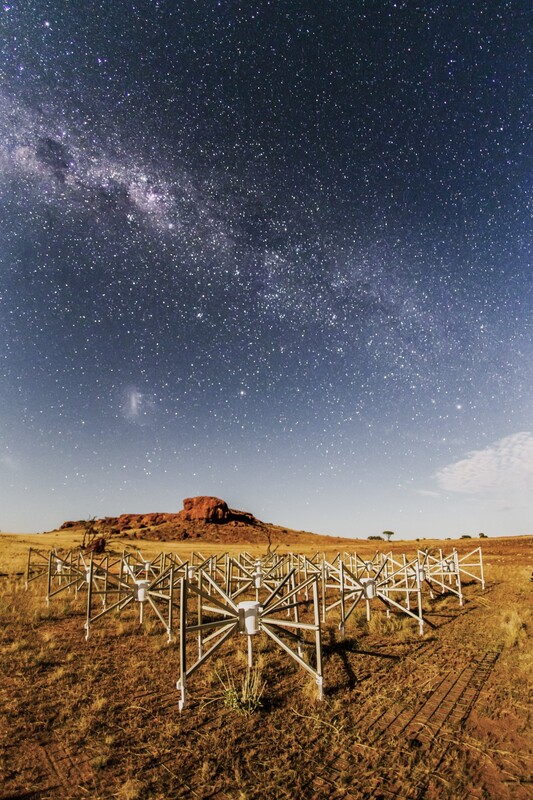
Last year, a $1 million Australian Government grant enabled the Murchison Widefield Array (MWA) to undergo ‘brain surgery’ – its resulting processing capability is being hailed as a significant technological achievement and feat of software engineering.
The project might seem simple in concept: replace the insides of the MWA telescope’s computing racks. Of course, this task becomes more complicated when you consider that these computing racks have the crucial job of combining and processing every byte of data from thousands of antennas, and astronomers around the world rely on the quality and accuracy of its output.
These important computing racks are collectively called the correlator, best understood to be the ‘brain’ of radio telescopes like the MWA. The $1 million grant awarded in late 2020 allowed the purchase of a literal tonne of brand-new computing equipment, which would become the basis of the MWA’s new correlator, named ‘MWAX’ (with the ‘X’ in reference to the cross-correlation function it performs). MWAX was designed to not only replace its aging predecessor, but to improve the MWA’s data systems and support the telescope’s flexibility.
The MWA is an international project to operate a ground-breaking low-frequency radio telescope in the Murchison region of Western Australia. The MWA first began scanning the southern skies in mid-2013, and the project has seen significant upgrades to its hardware since then – but the correlator has remained untouched for the best part of a decade.
This original correlator contained many limitations, with only enough inputs to process half of the MWA’s 4,096 antennas at any one time (the design requirement in 2012). MWAX was designed with no such limitations – capable of performing 900 trillion floating-point calculations each second, with 24 Hewlett Packard Enterprise (HPE) servers each containing enterprise-grade A40 Graphics Processing Unit (GPU) cards. Together, these servers provide 1.4 million gigabytes of local storage for observations, before the data products are sent over fibre optic cable to Perth where they can be accessed online by astronomers around the world.
MWAX was custom-designed by an engineering team at Curtin University, the lead institute for the MWA telescope. The upgrade involved in-house software development, procurement, and benchmarking of state-of-the-art hardware systems, end-to-end testing, deployment, and installation on site, and finally, engineering and science commissioning. Remarkably, these efforts took only a year to complete, despite the challenges of an ongoing pandemic and global shortage of GPUs.
This month, it was announced that the MWAX correlator was a finalist for the 2022 Engineers Australia Project Excellence Award for its contributions to scientific and technological advances. A technical description paper has also been written by Morrison et al. entitled “MWAX: A new correlator for the Murchison Widefield Array”, featured in the Publications of the Astronomical Society of Australia.
Curtin University Project Officer, Mia Walker, helped support MWAX from inception to completion, finding the process extremely rewarding.
MWAX was always the next step in the MWA’s evolution, which turned out to be more of a giant leap, really. I think it’s the best example of how we are achieving our goal to provide the highest quality data and service to the MWA Collaboration.
Since completion of commissioning in December 2021, the new correlator has received extremely positive feedback from MWA science teams and has exceeded expectations in key performance areas of operation (including visibility generation for over 100 different frequency and time resolutions, voltage capture and multicasting, and the integration of MWA’s new software libraries and archiving pipelines).
With a slew of new observing modes on offer, MWAX provides radio astronomers with greater opportunities to perform innovative science – which will likely add to the growing list of the MWA’s scientific achievements.
Among these, the MWA was instrumental in the detection of the largest known eruption in the universe since the Big Bang; the discoveries of ionospheric structures in the Earth’s atmosphere; a possible ultra-long period magnetar; the creation of a catalogue of 300,000 galaxies; and the first radio-colour panorama of the Universe.
See this link for press releases and popular media coverage related to MWA science.
The MWA’s capabilities also underpin its critical role as a ‘low-frequency precursor’ instrument for the $2 billion Square Kilometre Array (SKA) project. Having commenced construction in 2021, the SKA will be the world’s largest radio astronomy observatory, designed to solve the deepest mysteries of the Universe, with telescopes in Western Australia and South Africa.
MWAX was funded via a National Collaborative Research Infrastructure Strategy (NCRIS) Contingency Reserve grant of $1M from the Department of Education Skills and Employment, provided to Curtin University and administered by Astronomy Australia Limited (AAL).

[…] AAL News Release on MWAX: https://astronomyaustralia.org.au/blog/news/major-upgrade-to-outback-telescope-a-resounding-success/ […]